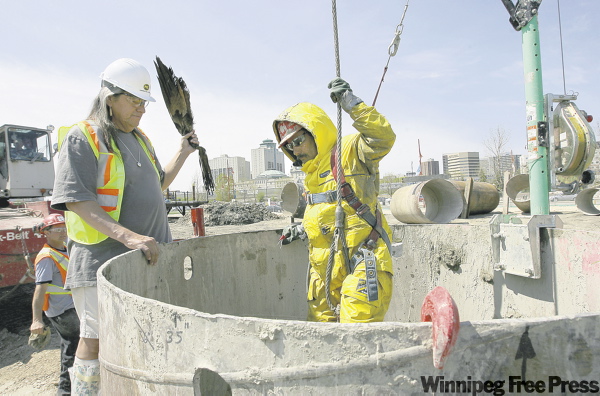Bless museum’s sacred ground
Native elders work with crews during construction
Advertisement
Read this article for free:
or
Already have an account? Log in here »
To continue reading, please subscribe:
Monthly Digital Subscription
$1 per week for 24 weeks*
- Enjoy unlimited reading on winnipegfreepress.com
- Read the E-Edition, our digital replica newspaper
- Access News Break, our award-winning app
- Play interactive puzzles
*Billed as $4.00 plus GST every four weeks. After 24 weeks, price increases to the regular rate of $19.00 plus GST every four weeks. Offer available to new and qualified returning subscribers only. Cancel any time.
Monthly Digital Subscription
$4.75/week*
- Enjoy unlimited reading on winnipegfreepress.com
- Read the E-Edition, our digital replica newspaper
- Access News Break, our award-winning app
- Play interactive puzzles
*Billed as $19 plus GST every four weeks. Cancel any time.
To continue reading, please subscribe:
Add Free Press access to your Brandon Sun subscription for only an additional
$1 for the first 4 weeks*
*Your next subscription payment will increase by $1.00 and you will be charged $16.99 plus GST for four weeks. After four weeks, your payment will increase to $23.99 plus GST every four weeks.
Read unlimited articles for free today:
or
Already have an account? Log in here »
Hey there, time traveller!
This article was published 02/06/2009 (5979 days ago), so information in it may no longer be current.
Aboriginal elders are making sure that Mother Earth is on side with the construction of the Canadian Museum for Human Rights.
Every time construction crews drill into the ground, to allow the pouring of dozens of concrete caissons or the pounding of hundreds of piles to stabilize the museum’s foundation, a bag filled with aboriginal medicine is put into the bottom of the hole.
Keith Bousquet, a worker with Subterranean Ltd., the company that’s putting in the caissons and piles, said he has so far placed the medicine bags into about 20 holes.

"I’m Métis and this means a lot to me," Bousquet said on Monday, shortly after emerging from a hole at least 50 metres deep.
"It’s a big honour and it’s a big privilege… someday I’ll be bringing my grandchildren here and telling them."
Larry Monkman, an aboriginal elder with the council of elders at Thunderbird House, said they were pleased when museum officials asked how they could properly construct the building on land that once served as a historic meeting place for aboriginals.
"We told them, same as Thunderbird House, that before any pile is put in, the medicine must be put down," Monkman said.
"It’s an ongoing sign of respect. It’s respect for Mother Earth and asking forgiveness for digging the holes."
Monkman said every week he creates and blesses the medicine bags and delivers 21 of them to the construction site at The Forks.
"I put sage, sweetgrass, tobacco and cedar in. They’re our four main medicines," he said.
"When they’re put in the hole we ask Mother Earth for her forgiveness for putting a hole into her."
Monkman said the person putting the medicine in the hole has to have been drug- and alcohol-free for at least four days.
"I’d like to see it done at all construction sites. Any place is sacred where people have gathered."
Todd Craigen, construction manager for PCL Constructors, said the addition of aboriginal medicine has not affected the construction.
"We’ve done work for aboriginal people before. We built Thunderbird House," he said. "It has been incorporated into the work."
Craigen said 134 caissons are being poured on the site as well as 378 piles. The depths vary from about 15 metres underground to 25 metres before reaching bedrock.
He said with the caissons, the medicine bag is put near the bottom of the hole, but with the piles, the bag is put on top of a two-metre-long base before the pile is hammered in from above.
Angela Cassie, a museum spokeswoman, said they recognized during the construction planning stage that they had to meet with the aboriginal community about the site.
"We recognize the importance of what this land represents to First Nations and Metis communities," Cassie said.
"Even before doing any archeological work we met with them.
"It is in our plan to continue to meet with them."
kevin.rollason@freepress.mb.ca

Kevin Rollason is a general assignment reporter at the Free Press. He graduated from Western University with a Masters of Journalism in 1985 and worked at the Winnipeg Sun until 1988, when he joined the Free Press. He has served as the Free Press’s city hall and law courts reporter and has won several awards, including a National Newspaper Award. Read more about Kevin.
Every piece of reporting Kevin produces is reviewed by an editing team before it is posted online or published in print — part of the Free Press‘s tradition, since 1872, of producing reliable independent journalism. Read more about Free Press’s history and mandate, and learn how our newsroom operates.
Our newsroom depends on a growing audience of readers to power our journalism. If you are not a paid reader, please consider becoming a subscriber.
Our newsroom depends on its audience of readers to power our journalism. Thank you for your support.


